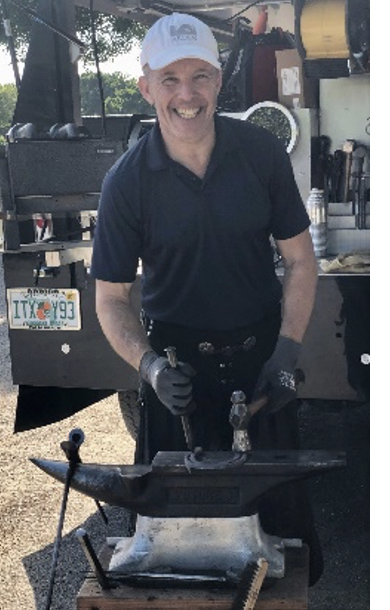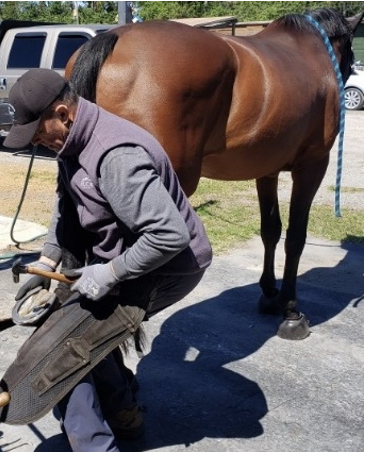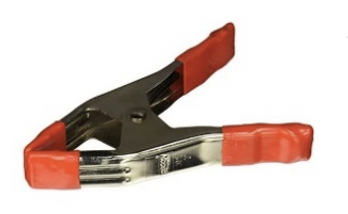| An Appropriate Working Environment for The Farrier Stephen E. O’Grady, DVM  My good friend and well-known Wellington, FL farrier, Fabio Gnoatto, published an article in the American Farriers Journal in 2017 describing the ideal working environment for the farrier. I subsequently included these guidelines in my chapters on farriery that I wrote in the textbook Adams Lameness in Horses published last year. Farriery is a difficult profession, and the farrier should be provided with the best working conditions possible which make the farrier more comfortable, more efficient and the job far more pleasant. Owners, clients, and trainers should show respect for their farrier by providing an appropriate environment in which to work. It may be useful to review this article and emphasize some of the key points that Fabio describes. My good friend and well-known Wellington, FL farrier, Fabio Gnoatto, published an article in the American Farriers Journal in 2017 describing the ideal working environment for the farrier. I subsequently included these guidelines in my chapters on farriery that I wrote in the textbook Adams Lameness in Horses published last year. Farriery is a difficult profession, and the farrier should be provided with the best working conditions possible which make the farrier more comfortable, more efficient and the job far more pleasant. Owners, clients, and trainers should show respect for their farrier by providing an appropriate environment in which to work. It may be useful to review this article and emphasize some of the key points that Fabio describes. The Workplace  When possible, a designated area for the farrier is ideal which should be quiet and away from the daily activity of the barn. If not, a quiet section of the barn or barn aisle should be used. The area should be clean and dry with the floor being level and firm; if not, rubber mats should be provided. There should be another flat firm area outside the barn where the horse can be observed in motion, the landing pattern of the foot can be evaluated, and any lameness noted prior to the farriery. Good lighting from all sides is essential…this author prefers daylight as opposed to artificial lightening when possible. In the winter, the farrier should be sheltered from the wind and the cold; in the summer, the farrier should be protected with shade against direct sunlight and the area should be readily accessible to fans. Fortunately, during this era of Covid 19, most horses stand quietly on the cross ties and do not need to be held while being shod. However, some horses require an attendant to stand at the horse’s head but having multiple people around the horse while the farrier is working should be discouraged. Sudden activity or movements may scare the horse, especially when a foot is lifted of the ground and the horse is unstable. As farriery is a routine procedure, unruly horses should be handled with physical restraint and training methods when possible rather than using sedation. If sedation is required, it is always best to have a veterinarian administer the medication. When possible, a designated area for the farrier is ideal which should be quiet and away from the daily activity of the barn. If not, a quiet section of the barn or barn aisle should be used. The area should be clean and dry with the floor being level and firm; if not, rubber mats should be provided. There should be another flat firm area outside the barn where the horse can be observed in motion, the landing pattern of the foot can be evaluated, and any lameness noted prior to the farriery. Good lighting from all sides is essential…this author prefers daylight as opposed to artificial lightening when possible. In the winter, the farrier should be sheltered from the wind and the cold; in the summer, the farrier should be protected with shade against direct sunlight and the area should be readily accessible to fans. Fortunately, during this era of Covid 19, most horses stand quietly on the cross ties and do not need to be held while being shod. However, some horses require an attendant to stand at the horse’s head but having multiple people around the horse while the farrier is working should be discouraged. Sudden activity or movements may scare the horse, especially when a foot is lifted of the ground and the horse is unstable. As farriery is a routine procedure, unruly horses should be handled with physical restraint and training methods when possible rather than using sedation. If sedation is required, it is always best to have a veterinarian administer the medication. The Environment Warm/hot weather presents a challenge to the farrier especially with regards to flies. During hot weather, it is particularly important to have adequate shade in the workplace to protect the farrier from direct sunlight, good air circulation using fans and a clean work area. This means sweeping the floor every time a foot or at least every two feet are trimmed. The trimmings and manure should always be swept at least six feet behind the horse. Swept to the front or side of the horse, the debris will still attract flies to the horse’s face or body. The broom is an important tool that every farrier should carry in his/her truck. The farrier should carry a good quality fly spray and spray the horse as needed; however, the owner’s permission is necessary and essential. Some horses don’t like to be sprayed which could result in the animal getting hurt and some horses may be allergic to various brands of fly spray. Permission from the owner/trainer relieves the farrier of any liability issues.  A practical tip that can be used during fly season when necessary is to place a spring clamp (available at Home Depot) in the tail hairs near the base of the tail which prevents the horse swishing its tail; this minimizes the risk of injury to the farrier’s eyes by the tip of the tail when the odd fly lands on the horse. A practical tip that can be used during fly season when necessary is to place a spring clamp (available at Home Depot) in the tail hairs near the base of the tail which prevents the horse swishing its tail; this minimizes the risk of injury to the farrier’s eyes by the tip of the tail when the odd fly lands on the horse. The thoughts discussed above are relatively easy to institute and can provide a huge difference in not only the comfort of the farrier but also the comfort of the horse. Be safe. |